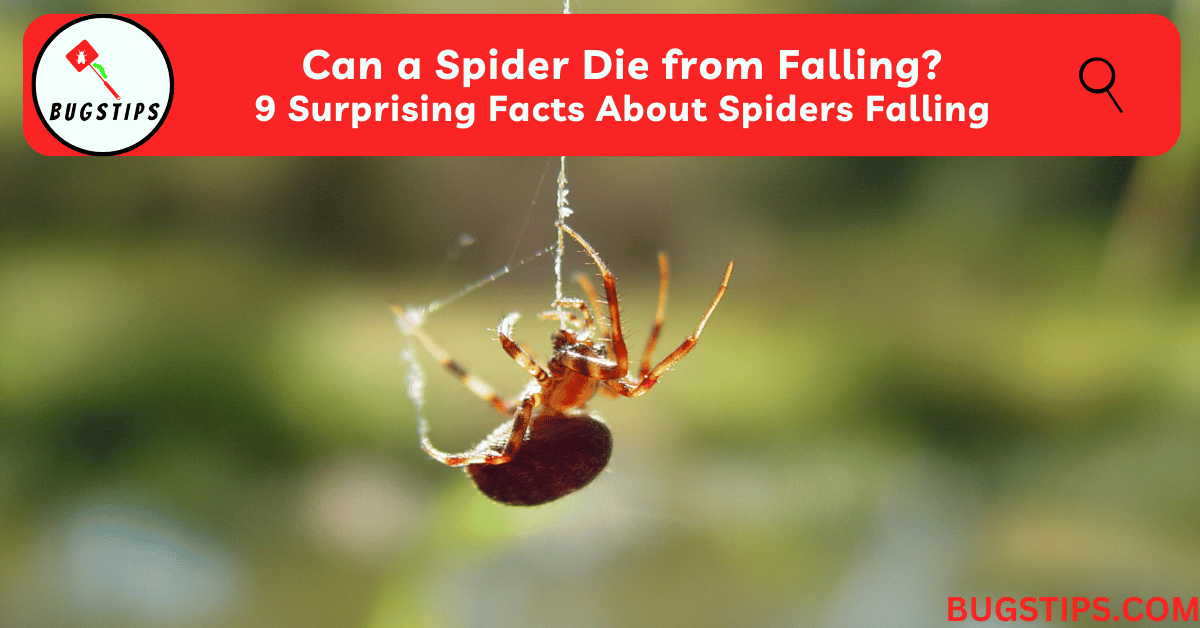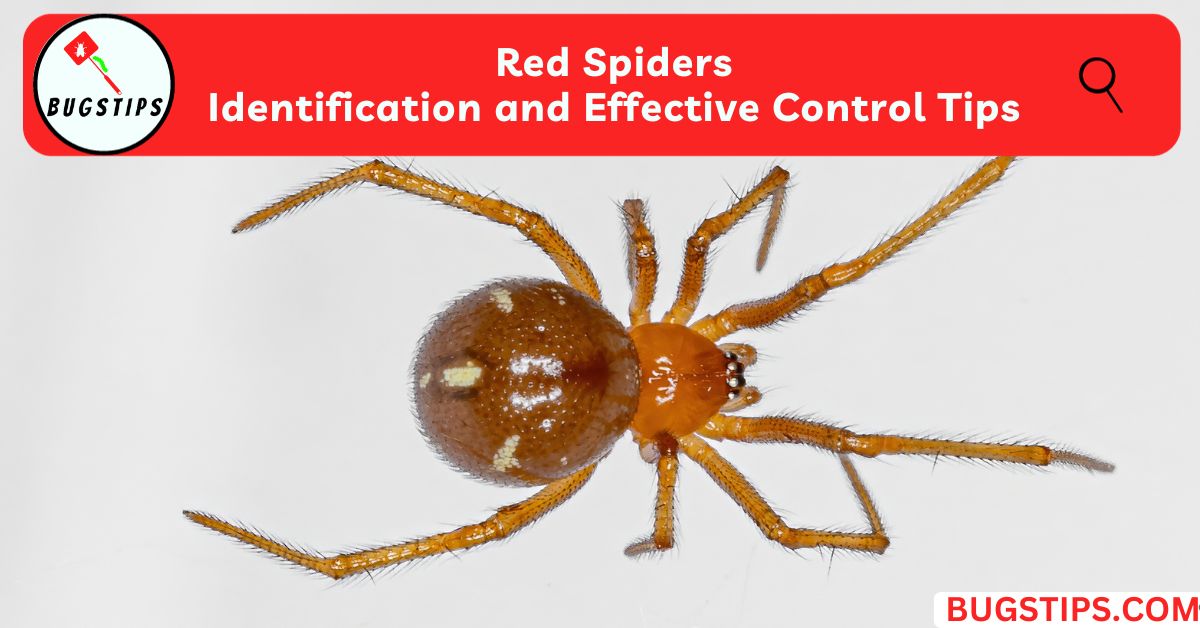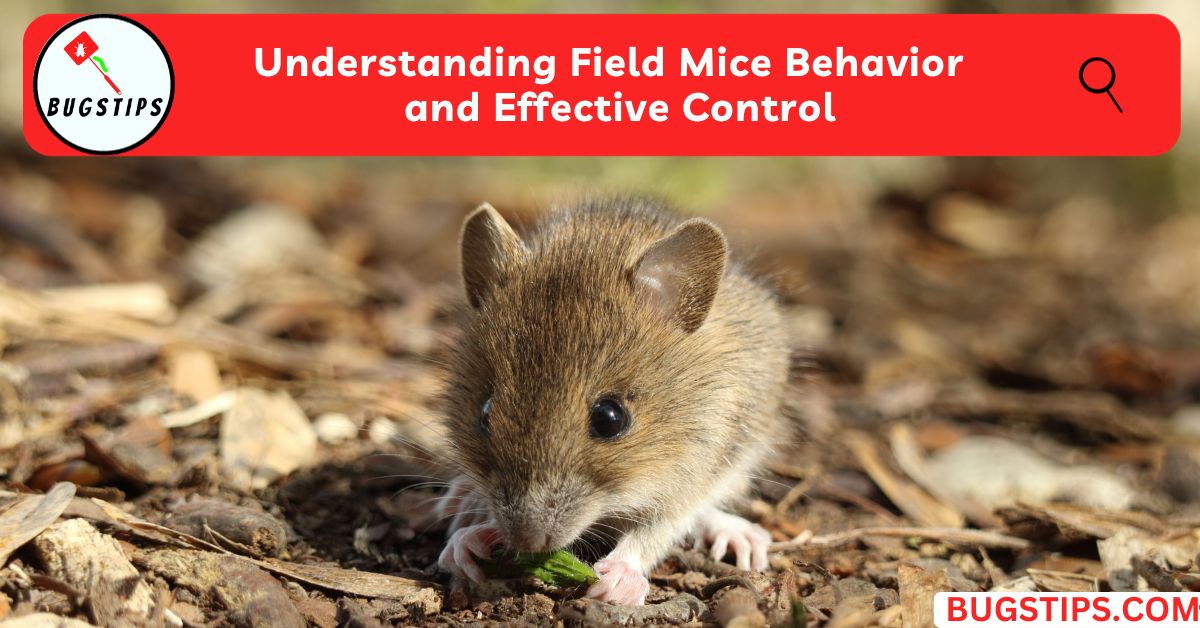This post may contain affiliate links which means as an Amazon Associate, this site may earn a small commission on qualified purchases made through links at no extra cost to you. Learn more on Affiliate Disclosure
Spiders are fascinating creatures with incredible survival skills, but can a spider die from falling?
This is a question that many people ask, and in this article, we’ll explore the answer.
Despite their small size, spiders can withstand falls from significant heights thanks to their physical characteristics.
We’ll take a closer look at the reasons why spiders may fall and the physical characteristics that allow them to survive to fall.
We’ll also discuss some misconceptions about spiders and falling and what happens to them when they don’t survive a fall.
So, if you’re curious about whether spiders can die from falling and want to learn more about these fantastic creatures, keep reading!
Related Article – Can Squirrels Die From Falling? The Amazing Facts
Can a Spider Die from Falling?
Spiders can die from falling, depending on the height of the fall and the surface they land on.
While spiders have evolved several unique adaptations that allow them to survive falls from significant heights, there are limits to their resilience.
Factors such as the spider’s size and weight, the surface it falls onto, and the height of the fall can all impact the spider’s ability to survive.
In the following sections, we’ll explore the science of spider falls in more detail, including the terminal velocity of spiders, their web-slinging and parachuting abilities, and their physiological adaptations.
By understanding the mechanics of spider falls, we can better appreciate these incredible creatures and their remarkable abilities to survive in their environments.
Related Article – Do Spiders Feel Pain? The Truth Behind Myths
Can a spider die from falling on its back in a puddle?
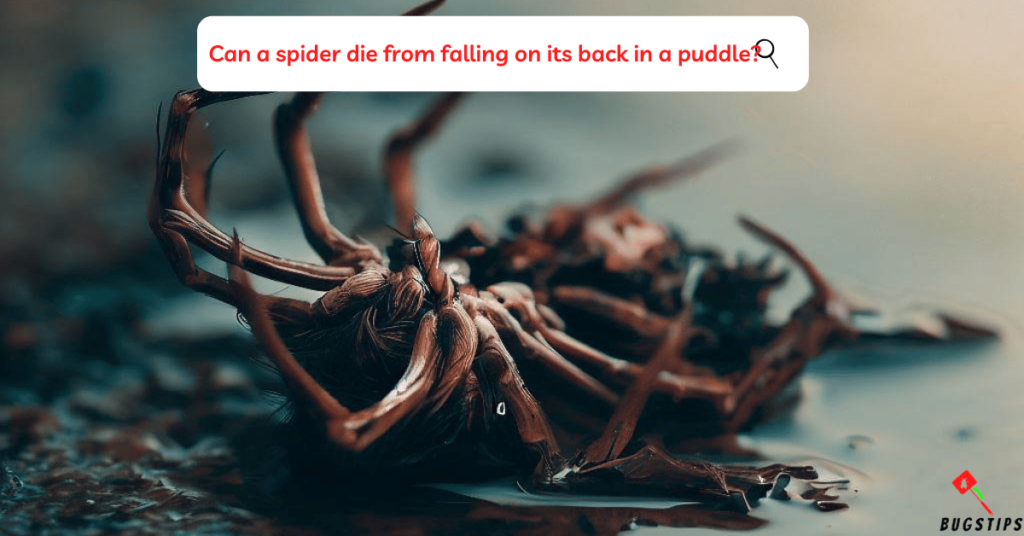
Yes, a spider can die from falling on its back in a puddle. When a spider falls on its back, it can become disoriented and struggle to right itself.
This can be especially dangerous if the spider falls into a liquid, as it may not be able to swim or climb out.
If a spider falls into a puddle and is unable to right itself, it may eventually drown. The length of time it takes for a spider to drown can vary depending on the species, size, and temperature of the water.
It’s worth noting that not all spiders are equally at risk of drowning.
Some species, such as fishing spiders, are well-adapted to aquatic environments and can even hunt underwater.
Other spiders, however, may not be as well-equipped to survive in water.
You’ll Also Like – Can Spiders Bite Through Leggings, Socks, and Gloves?
The Science of Spider Falls
Spiders have evolved several unique adaptations that allow them to survive falls from significant heights.
These adaptations include their ability to regulate their terminal velocity, use their silk to control their descent and prevent injuries, and their physiological adaptations that help them withstand the impact of a fall.
Terminal Velocity
Terminal velocity is the point at which the force of gravity pulling an object downward is balanced by the air resistance pushing against it, resulting in a constant velocity.
For spiders, their terminal velocity is relatively slow due to their small size and lightweight.
This means that they can fall from relatively great heights without experiencing a high impact force upon landing.
Spiders are able to reach their terminal velocity relatively quickly due to their shape and size.
Their small size means that they experience less air resistance than larger objects, allowing them to accelerate more quickly.
Additionally, their shape allows them to fall in a streamlined manner, further reducing air resistance and increasing their acceleration.
It is important to note, however, that a spider’s terminal velocity can vary depending on its size, weight, and air density in its environment.
For example, a larger spider will experience more air resistance and reach its terminal velocity more slowly than a smaller spider.
Similarly, a spider falling through a denser atmosphere, such as at higher altitudes, will reach its terminal velocity more slowly than a spider falling through a less dense atmosphere.
Web-Slinging and Parachuting
Web-slinging and parachuting are two methods that spiders use to control their descent when falling from great heights.
Spiders are well-known for their ability to produce silk, which they use for various purposes, including web-slinging and parachuting.
When a spider falls, it can quickly produce silk to form a dragline, which it uses to control its descent.
The spider will use its hind legs to produce silk and release it into the air, allowing the wind to catch the silk and slow the spider’s fall.
The spider can then reel in the silk to control its descent and land safely on a suitable surface.
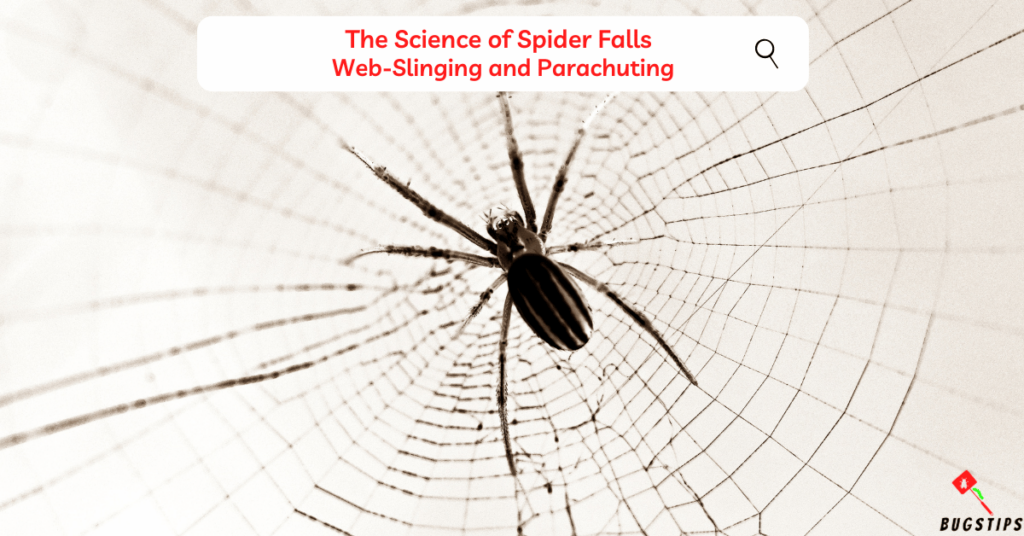
Some species of spiders are also capable of parachuting, which involves releasing a strand of silk that catches the wind and carries the spider through the air.
This technique is similar to gliding and allows spiders to travel long distances through the air without expending much energy.
The ability to produce silk and use it for web-slinging and parachuting is an important adaptation that allows spiders to survive falls from great heights.
By using their silk, spiders can control their descent and avoid serious injury upon landing.
Related Article – Do Spiders Feel Pain? The Truth Behind Myths
Physiological Adaptations
Spiders have also evolved a number of physiological adaptations that allow them to survive falling from great heights.
One of the most important adaptations is their exoskeleton, which provides protection for their internal organs upon impact.
In addition, spiders have a high surface area-to-volume ratio, which allows them to slow their fall and reduce the force of impact upon landing.
This is because their small size and light weight allow them to experience more air resistance, which slows their fall and reduces their terminal velocity.
Spiders also have flexible joints and leg muscles that allow them to absorb the impact of a fall and avoid serious injury.
This allows them to quickly recover and continue moving after a fall, rather than becoming incapacitated or dying.
Why Do Spiders Fall?
Spiders fall for a variety of reasons, including accidental falls from their webs or other surfaces, intentional jumps or drops as a means of escape or predation, and wind or weather conditions that dislodge them from their perches.
Accidental falls are a common occurrence for spiders, especially those that build webs in high places or on unstable surfaces.
These falls can occur due to a variety of factors, such as the weakening of a web from age or damage, or the loss of grip on a smooth surface.
Some spider species also intentionally jump or drop from heights as a means of escape or predation.
For example, some jumping spiders are known for their impressive leaping abilities, which they use to capture prey or evade predators.
Weather conditions, such as strong winds or heavy rain, can also cause spiders to fall from their perches.
This can be particularly dangerous for spiders that build webs in high places or on unstable surfaces, as they may be more susceptible to being blown off or dislodged by the wind.
While falling is an inherent risk for spiders, they have evolved a number of adaptations that allow them to survive falls and continue moving despite the potential dangers.
From their silk production and control of descent to their physical and physiological adaptations, spiders have developed a range of tools to help them navigate the hazards of their environment.
You May Also Like – Can Spiders Swim? A Fascinating Look
Do Spiders Fall Off Ceilings?
Spiders are often found crawling on walls and ceilings, and it’s not uncommon for them to fall off.
While spiders have the ability to climb walls and walk on ceilings, they can sometimes lose their footing or grip and fall.
This can be due to various factors such as the surface texture or angle of the ceiling, sudden movements or vibrations, or simply losing their balance.
However, falling off a ceiling is not necessarily harmful to a spider, as they have several adaptations that allow them to survive falls from great heights.
In fact, falling from a ceiling is usually not a significant enough height to cause any harm to a spider. They can simply crawl back up or continue their journey on the ground.
It's important to note that not all spiders are climbers or ceiling walkers, and some species prefer to live on the ground. So while spiders may sometimes fall off ceilings, it's not something that happens to all spiders in all situations.
What Happens to Spiders that Fall?
When spiders fall from a great height, their chances of survival depend on a variety of factors.
While many spiders are able to survive falls from moderate heights, such as those from a ceiling or a plant, falls from greater heights can be fatal.
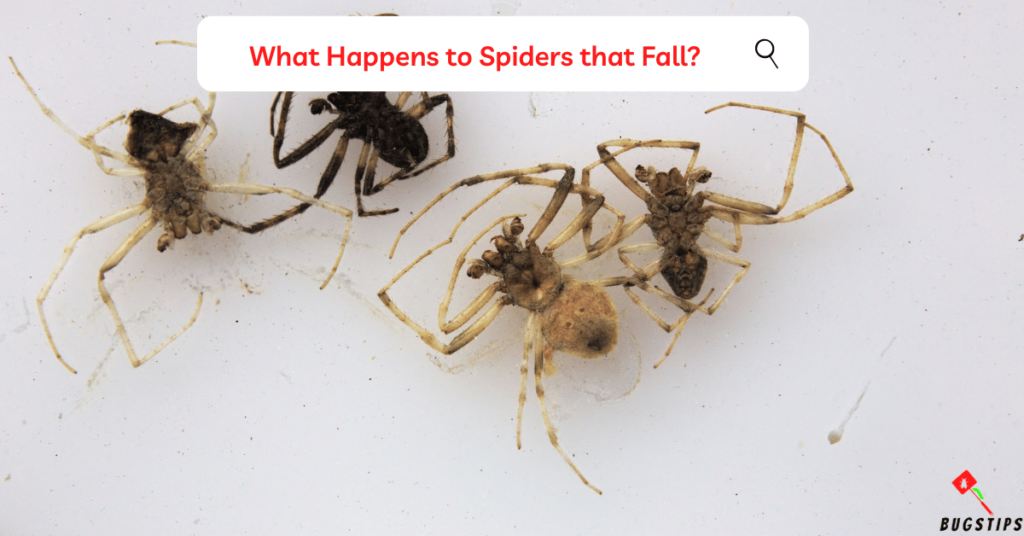
Spiders that fall and do not survive may suffer injuries from the impact, such as broken legs or ruptured organs.
In addition, spiders that fall onto hard surfaces, such as pavement or concrete, may be more likely to suffer fatal injuries compared to those that fall onto softer surfaces like grass or leaves.
After a fall, spiders may face several challenges when navigating back to their web or nest. If the fall takes them far away from their home, they may have difficulty finding their way back.
In addition, spiders may be disoriented or injured from the fall, making it harder for them to move around and find their way.
Predators can also pose a threat to fallen spiders. Birds, lizards, and other animals may take advantage of a weakened or injured spider and prey on it before it has a chance to recover from the fall.
As a result, spiders that fall may be at an increased risk of predation compared to those that remain in their webs or nests.
Factors that Affect Spider Survival
When a spider falls, whether or not it survives depends on several factors. One of the most critical factors is the height of the fall.
Height
Height is one of the primary factors that affect the likelihood of a spider surviving a fall. Spiders that fall from lower heights are more likely to survive than those that fall from higher heights.
This is because spiders have the maximum speed that they can reach during a fall, known as their terminal velocity.
The higher the spider falls, the faster it will reach its terminal velocity, and the more likely it is to sustain injuries or die upon impact.
Surface
When it comes to surfaces, the type and texture of the landing spot can play a significant role in a spider’s survival after a fall.
Soft and springy surfaces, such as foliage or soil, can help cushion the impact and reduce the risk of injury.
On the other hand, hard and smooth surfaces, like concrete or glass, can increase the chances of injury or death.
Spiders that fall into the water may also face unique challenges. While some spider species can swim, others may become trapped in the surface tension of the water and be unable to escape.
Additionally, spiders that fall onto surfaces covered in oil or other substances may become coated and unable to move, leading to a slow and painful death.
Age and Health
The age and health of a spider can play a significant role in its ability to survive a fall.
Younger spiders and those in good health are generally more likely to survive falls than older or weaker spiders.
This is because their bodies are more resilient and better equipped to handle the impact of a fall.
Older spiders may have weaker exoskeletons or be more prone to health problems that can make them more susceptible to injury or death from a fall.
Additionally, spiders that have recently molted, shedding their exoskeleton to grow a new one, may be more vulnerable to injury since their new exoskeleton is not fully hardened and may be more delicate.
How Far Can a Spider Fall Without Dying
Spiders can die from a fall at any distance, but the likelihood of death depends on a variety of factors, as we have previously discussed.
However, researchers have found that spiders can survive falls from surprisingly great heights.
For example, some species of spiders have been known to survive falls from heights of up to 20 stories, or approximately 200 feet.
The survival of a spider after a fall depends on its size, the surface it lands on, and other factors, but in general, spiders are relatively resilient creatures that can endure falls from much greater heights than their own bodies.
Do Spiders Survive Being Thrown Out the Window?
It is possible for spiders to survive being thrown out of a window, but it largely depends on several factors.
The height from which they were thrown, the surface they land on, and their age and health all play a role in determining their chances of survival.
If a spider is thrown out of a window from a significant height, it may not survive the fall. However, some species of spiders have been known to survive falls from great heights, up to 70 feet or more.
This is due to their ability to adjust their posture in mid-air and land on their legs, as well as their ability to release silk strands to slow their descent.
The surface on which the spider lands also plays a crucial role in its survival. If the surface is soft, such as grass or leaves, it may cushion the spider’s fall and increase its chances of survival.
However, if the surface is hard, such as concrete or pavement, the spider is more likely to suffer serious injuries or even death.
As we explained before the age and health of the spider are also important factors in determining its ability to survive being thrown out of a window.
Older or weaker spiders may not be able to withstand the impact of the fall, while younger and healthier spiders may have a better chance of survival.
How Can You Help Fallen Spiders?
If you come across a fallen spider and want to help, there are a few things you can do.
First and foremost, it’s important to remember that spiders are wild animals and can bite or become defensive if they feel threatened.
It’s best to approach them cautiously and avoid handling them directly if possible.
One way to help a fallen spider is to gently nudge it onto a piece of paper or cardboard and move it to a safe location, such as a nearby plant or tree.
This can help the spider avoid being stepped on or becoming prey for other animals.
Another option is to provide a safe and sheltered area for the spider to recover. This can be as simple as placing a small container with some leaves or twigs near where the spider fell. The spider may use this as a temporary home until it is ready to move on.
If the spider appears injured or unable to move, it may be best to leave it alone and let nature take its course. In some cases, attempting to intervene can do more harm than good.
While it can be tempting to want to help a fallen spider, it's important to do so safely and with the animal's best interests in mind.
Final Thoughts
The question “Can a spider die from falling?” is not a straightforward one.
While falling can be dangerous for spiders, they have several physiological adaptations and behaviors that help them survive falls.
Factors such as height, surface, age, and health also play a role in determining whether a spider will survive a fall.
If you come across a fallen spider, there are ways you can help it, such as gently moving it to a safe area or providing it with a platform to climb back up.
It’s important to remember that spiders are valuable members of our ecosystems and deserve our respect and protection.
How far do spiders have to fall to die?
The height from which a spider would die from a fall depends on several factors, such as the surface it lands on, its health, and its species. Generally, a fall from a great height, such as a several-story building, would be fatal to most spiders. while others may not survive falls from just a few feet.
Does it hurt spiders when they fall?
It is not clear whether spiders experience pain in the way humans do, but they may experience some discomfort or injury from a fall, depending on the height and surface they land on.
How far can a tarantula fall without dying?
Tarantulas are relatively robust spiders known to survive falls from heights of several feet or more. However, a fall from a great height could still be fatal to a tarantula.
Are spiders affected by fall damage?
Spiders are affected by fall damage, just like any other creature. Falls from greater heights can cause more severe injuries, while falls onto hard surfaces can be more damaging than falls onto soft surfaces.
Are all spider species equally good at surviving falls?
No, different species of spiders may have different abilities to survive falls. Factors such as body size, silk production, and behavior may all play a role in determining a spider’s ability to survive a fall.
Do spiders die from a 3 story fall?
A fall from a height of three stories would likely be fatal to most spiders, but it depends on several factors, such as the surface they land on and their health.
Can spiders die if they fall off a bed?
It is unlikely that a fall from a bed would be fatal to a spider, especially if the bed is not very high. Spiders have adaptations that allow them to survive falls from low heights.
Can spiders climb back up the sink?
Spiders are skilled climbers and may be able to climb back up a sink if they have a surface to grip onto, such as a rough or textured surface. However, some spiders may not be able to climb smooth surfaces.
Why do spiders fall off the ceiling?
Spiders may fall off the ceiling for various reasons, such as losing their grip, being disturbed by vibrations or air currents, or misjudging the distance between surfaces.
Resources – (for further reading)
JSTOR – Ballooning: Data from Spiders in Freefall Indicate the Importance of Posture

